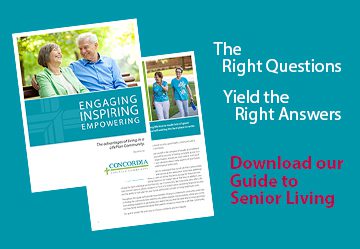Downsizing, Rightsizing and Simplifying After Retirement
If you’re an adult who’s at or near retirement, you’re probably going over your options and how you can best enjoy your time. That may include adjusting your living arrangements so you can focus on the people and activities you enjoy most.
Your post-retirement years are meant to be full of fun, socializing and spending time with family. That’s why so many adults consider downsizing, rightsizing and simplifying in the first place. In this article, we’ll take a look at each of these techniques, what they are and how they can benefit you.
What is Downsizing?
Downsizing is the process of moving out of your current home into something smaller and better suited to your lifestyle.
As you reach retirement and go through normal changes, such as your kids moving out, the amount of house you have can be too much space and a financial burden. When you downsize, you benefit from potentially saving money on things like your mortgage if you have one, bills related to the upkeep of your home and more. It can also help with mobility issues for those that may have difficulty dealing with stairs or other features of a home that prevent easy movement.
What to Consider When Downsizing
When considering downsizing in your home or lifestyle, you’ll need to take some other things into account so you can make the best possible choices for your next home. For instance:
- What is the potential emotional impact and the cost to move?
- What type of living arrangement will you need?
- Is independent living your next move, such as a retirement community or active adult neighborhood?
- Do you have medical or daily living assistance needs that would make an assisted living arrangement ideal?
The type of community you choose will determine how much you need to downsize as will the amount of space you want. Are you okay with a one-bedroom apartment or would you prefer two bedrooms? Before starting to downsize, decide how you want your life to look. That will guide you in determining how much or how little to downsize.
What is Rightsizing?
While downsizing is an action you take, rightsizing is a state of mind. It’s a philosophy. Author Kathy Gottberg wrote a book on the subject and defined rightsizing as:
“The conscious choice to create a life and a lifestyle that more sustainably aligns with your unique self in the best possible way at every stage.”
With rightsizing, you ask yourself what’s most important to you and then put yourself in a situation that allows for that.
In many ways, rightsizing is similar to downsizing because you’re typically reducing your space or material possessions until you’re left with the most important elements in your life. The mindset behind rightsizing is more positive, however. It gives you the freedom to choose the right time and the right amount of changes. For retirees, rightsizing can be a more positive way to make life changes, such as deciding to move into a retirement community that offers you simplicity and convenience. This can be less about the size of your home and more about the value you get from where you live.
Things to Consider When Rightsizing
Like with downsizing, rightsizing has several considerations. For example, you should consider:
- Your physical and mental health
- Financial ability to support a change
- Family proximity to a potential new home
- Your lifestyle preferences
Rightsizing is also a great mindset for adults who need some type of support. Nearly 70 percent of those aged 65+ need long-term care, which often means giving up a larger home for less space, but more support that empowers your lifestyle. Putting yourself in a rightsizing mindset can allow for this reality to happen on your terms. You’re giving up space, but gaining the support you need to pursue your goal lifestyle. You’re rightsizing for where you are now.
What is Simplifying?
Simplifying is the practice of cutting out distractions and elements, people or belongings in your life that take your attention away from what’s most important to you.
Simplifying isn’t about needing or wanting to move, it’s about making things in your life easier and, of course, simpler.
Many adults who enter retirement find simplifying attractive because they realize they have a lifetime of things they don’t necessarily need. Simplifying can also be viewed as an approach to downsizing or rightsizing, including the preparation and how you make the change.
What to Consider When Simplifying
When you’re ready to simplify your life and living situation, ask:
- What spaces in your home do you use most, and which are less important to your everyday happiness?
- What belongings do you no longer use, but still take up space in your life?
- What obligations do you have that you don’t enjoy, such as housekeeping or laundry?
These questions will help you determine what changes will simplify your daily life. For instance, if you no longer enjoy laundry but do it regularly, you may consider a retirement community that provides laundry services when you’re downsizing or rightsizing.
Determining the Option That’s Right for You
Studies show that as many as 42% of Baby Boomers are ready to move or downsize, but not always into retirement communities.
When adults do choose to move into a senior living option, they are most often choosing a Life Plan Community also known as a Continuing Care Retirement Communities (CCRC). Life Plan Communities are unique because they offer independent living for active, healthy adults along with a full range of care so adults can stay in the same community as their support needs change. The typical Life Plan Community includes independent living, assisted living, memory care and skilled nursing.
Adults move to a Life Plan Community so they can get the most out of their active years while finding comfort in the knowledge that they have every transition option in their community as their needs change. And when they do move into such a community, they wonder why they didn’t do so sooner.
It’s not always easy to determine what you should do post-retirement. For those living in Oklahoma City or looking to move there, Concordia Life Plan Community can help you with all these decisions. Our community provides everything you need in the comfort of one community that you can transition through as you age.
Concordia takes a family approach to community, helping you through the simplifying process and the action of downsizing – all with a rightsizing philosophy. Things like support with your move, a cost calculator for figuring out the best option for you, and transition services to make it all easier. Contact us for more information on how we can help you find the right lifestyle for your retirement.
Retirement & Planning


